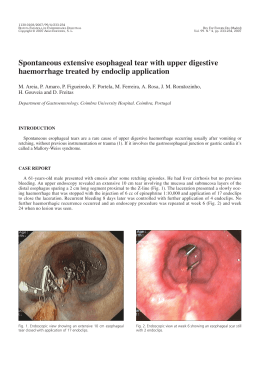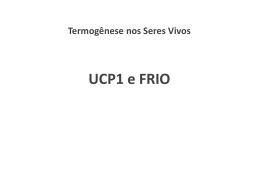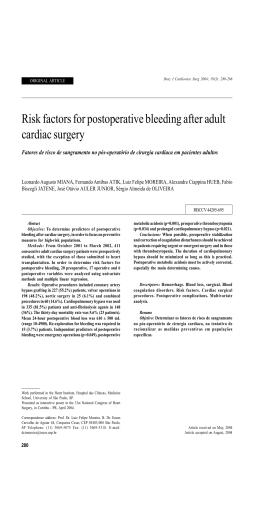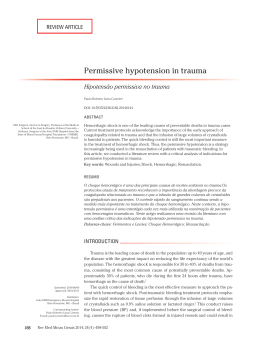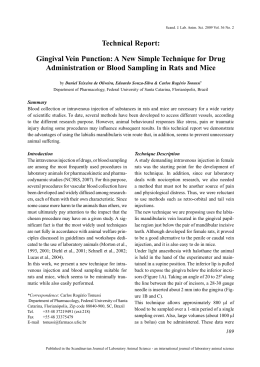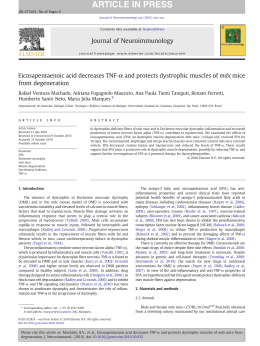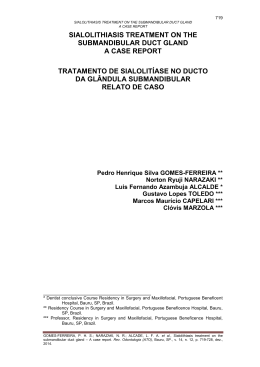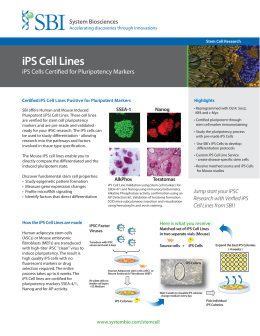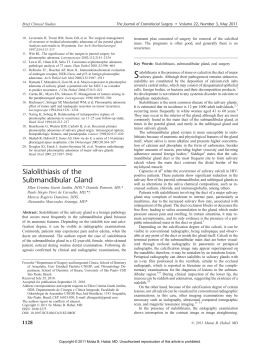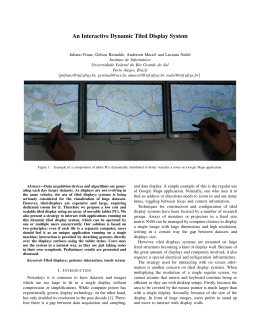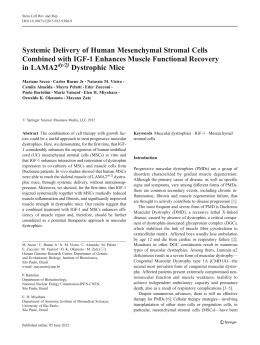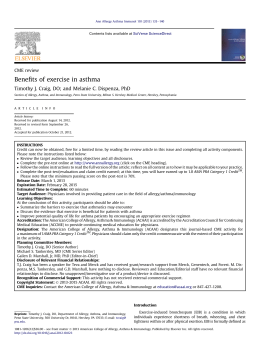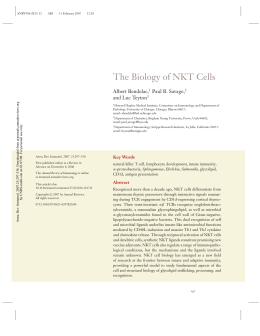TECHNIQUE A rapid, simple, and humane method for submandibular bleeding of mice using a lancet William T. Golde, PhD1, Peter Gollobin2 & Luis L. Rodriguez, DVM, PhD1 Methods for obtaining blood samples from mice tend to be difficult, inhumane, or both. The authors describe an inexpensive, disposable, single-use lancet for submandibular bleeding of mice that allows investigators to quickly draw 0.2–0.5 ml of blood without the use of anesthesia. When using small animals, such as mice, researchers must be able to acquire samples for testing. Drawing blood samples from mice is challenging because of the animal’s small size. Although Institutional Animal Care and Use Committees will approve protocols including several blood collection methods, none are particularly simple or humane. In the United States, the most common rodent bleeding method is retro-orbital, puncturing the orbital sinus behind the eye. This method consistently yields a reasonable blood volume (0.2–0.5 ml) when the investigator is experienced in executing the procedure 1. Nevertheless, poor technique can blind the animal, and several countries have banned this method because officials consider it to be inhumane. Another common method is cardiac puncture. This procedure requires anesthesia, which may alter parameters of the experiment. Briefly, one inserts a smallgauge needle into the ventricle and slowly draws out blood. This procedure requires a skilled investigator and is most commonly used as a terminal blood collection procedure; however, some investigators are able to keep animals alive for several blood collections2. This is not a simple method and is only humane when the procedure goes very well, leaving minimal damage to cardiac and pericardial tissues along the needle track. Missing the heart or passing the needle completely through the heart could lead to undetected internal bleeding or other complications. Because the chance of losing animals is so great, investigators choosing this method often supplement the number of animals requested for the research so as to accommodate loss during an experiment. A simple method of bleeding mice is the tail clip, in which a piece of the tail is excised and blood harvested from the severed tail vein. One can do this repeatedly for a few sequential bleeds. A major disadvantage is that to leave enough tail for several future bleeds, the portion of tail excised must be small, thus yielding a small blood sample of a few drops (<0.1 ml). Another problem with this method is that it could lead to cannibalism among cagemates and is not at all humane, especially for several blood draws. In addition, there is the tail laceration technique in which the mouse is restrained and an incision is made in the tail vein with a scalpel or razor blade. This technique yields as much as 0.5 ml of blood3; however, it usually requires anesthesia, and an incision made too deeply can complicate repair. Finally, a more humane method that is done without anesthesia is the saphenous vein puncture4. This is a complicated and time-consuming method that involves immobilizing the animals with the rear legs accessible. The investigator shaves the hair from the caudal surface of the thigh using a small scalpel or razor. The saphenous vein of the thigh is visible, and one can puncture it with a 23- to 25-gauge needle, then collect the blood with a microvette capillary collection tube. These tubes have a maximum volume of 0.3 ml. A compress held on the site will stop the bleeding. This is a more humane method of blood collection, and with no anesthesia required there are no side effects to consider. However, this procedure is slow, requiring extensive time working with each animal, and is not compatible with large trials of pharmaceuticals or biologicals. The time required to do a large trial (e.g., 50–100 animals) would cause researchers to 1Plum Island Animal Disease Center, ARS, USDA, Greenport, NY 11944. 2MediPoint Inc., Mineola, NY 11501. Correspondence should be addressed to W.T.G. ([email protected]). LAB ANIMAL Volume 34, No. 9 | OCTOBER 2005 39 TECHNIQUE FIGURE 1 | Bleeding from the mouse cheek targets the retro-orbital and submandibular veins draining the face of the mouse at the point that they join at the origin of the jugular vein. design smaller experiments using fewer animals. The investigators describing this method limit the amount of blood collected to 0.3 ml, and in practice, the blood volumes collected are even less. This commonly would yield ~0.1 ml of serum and limit analysis to a few very small-volume assays. Hoff has extensively reviewed all of these techniques5. SUBMANDIBULAR BLEEDING METHODS FOR MICE We have been using an alternative method for drawing blood samples from mice that is more rapid and humane. This is a method that has been used by colleagues for several years but requires a great deal of practice. A small vascular bundle at the back of the jaw characterizes the cheek of laboratory mice (Fig. 1). This is the point where the orbital veins, the submandibular vein, and other veins draining the facial region join to form the beginning of the jugular vein. The researcher holds the animal by the scruff of the neck in the air to establish the most relaxed situation for the mouse. Using FIGURE 2 | (a) The Goldenrod animal bleeding lancet removed from the sterile wrapper. (b) The Goldenrod animal bleeding lancet (5 mm point size) in a sterile wrapper and the blood collection vessel (Microtainer tube from B/D sold by Fisher Scientific). 40 Volume 34, No. 9 | OCTOBER 2005 a number 11 scalpel, the investigator pokes the cheek facing him or her with enough force to create a small stick hole, so that drops of blood exude from the point of penetration. The blood collection tubes used may or may not include separating gel for collection of serum and whole blood, and either heparin or EDTA as an anticoagulant. The position of the punch is crucial to obtain a sufficient volume of blood in a very short time, and with practice the investigator can become proficient at positioning the scalpel. One can collect as much as 0.7 ml of blood from an adult mouse depending on the frequency of bleeding. Simply applying a sterile gauze pad or tissue with a little compression for less than a minute will stop the bleeding. After the mouse is released, it will groom and within a short time will show no evidence of the blood draw. The problem with this method is that control of the scalpel during the stabbing process requires a fine touch that comes from many repetitions of the procedure. Even after much practice, the investigator often will not penetrate far enough with the scalpel, or worse, penetrate too deep and cause tissue damage. Investigators who are not yet proficient or who only occasionally bleed mice have often had frustration with the inconsistency of the procedure. Most often the application of insufficient pressure yields little or no blood. A stab that is too strong cuts the mouse cheek skin, which may require intervention to arrest the bleeding, and possibly sutures; this complication now elevates the procedure to minor surgery. In some cases the scalpel pokes through the inside of the cheek, causing blood to fill the mouth cavity and putting the animal in danger of death by blood aspiration and asphyxiation if the bleeding is profuse. Also, in stabbing high above the jaw, the investigator may punch into the ear canal causing bleeding from the ear. An alternative to the scalpel is to perform the same procedure using a 19-, 21-, or 23-gauge needle, depending on the size of the mouse. However, the disadvantages of needles are similar to those of scalpels; thus they can cause lacerations of the cheek and complications similar to those cited for the scalpel. In addition, a significant amount of blood coagulates inside the needle, resulting in poor blood yields. Some investigators have used this method successfully, but it is difficult to learn because of the need for consistency. MOUSE BLEEDING LANCET We have now developed an inexpensive, disposable, sterile single-use mouse bleeding lancet for the submandibular bleeding method. We based this device on the standard lancet used to take blood samples from infants’ heels or from the fingertips of children and adults. These lancets cause only momentary pain www.labanimal.com TECHNIQUE FIGURE 3 | (a) Positioning and poking the cheek with the lancet. (b) Collecting blood from the cheek. at the time of the puncture and leave no significant tissue damage, as demonstrated by dissection of the site 3 or 7 days later. For use in the mouse procedure, we determined that the length of the standard fingertip lancet, 3.0 mm, was too short. We produced and tested 4.0-mm and 5.0-mm lancets (Fig. 2a). In Figure 2b, we show the sterile, paperwrapped lancet with the blood collection tube, a B/D microtainer tube (Fisher Scientific, Pittsburgh, PA). As shown in Figure 3, the method is identical to the scalpel method, with the advantage that the lancets control the depth of the skin puncture such that there is a high degree of consistency in a blood draw with very little training. As shown in Figure 3a, the optimal puncture point is at the back of the jaw of the mouse, FIGURE 4 | The mouse after holding a sterile gauze compress on the bleeding site for 10–30 s. LAB ANIMAL very slightly behind the hinge of the jawbones, toward the ear. One can feel the jawbone with the lancet and should avoid the bone, instead puncturing the cheek just behind the point at which the upper and lower jawbones meet. We have found that holding the animal by the skin between the shoulder blades rather than between the ears tends to result in less distortion of the skin and presumably blood vessels on the face. There should be enough force in the thrust to quickly insert the point to the hilt. Once the stick has been made, one should quickly seize the collection tube, because blood can exude from the puncture very rapidly and often the flow slows in a very short time. For more detailed descriptions and a video example, see the supplier’s website (http://www.medipoint.com). The 5.0-mm lancets provided the best results with very few problems apart from finding the proper location for the lancet puncture. Blood volumes that we collected were always >0.3 ml, and bleeding could be stopped once we had collected a sufficient volume. The 4.0-mm lancets worked very well on young mice, 2- to 6-week-old BALB/c and C57Bl/6, and the 5.0mm lancets worked best for adult mice aged 2 months and older. For investigators doing long-term studies or working on aging, we developed a 5.5-mm lancet for the larger 9-month to year-old mice. After the procedure the animal shows little evidence of the blood draw (Fig. 4), and after a short period of grooming there is no evidence of the procedure. The mouse lancet eliminates the problems associated with the use of a scalpel or needle when drawing blood from the cheek. It makes the procedure easy, resulting in consistent quantities of blood of about between 0.2 and 0.5 ml with little chance of hurting the mouse. With firm pressure during the stick, we never made an incision all the way through to the inside of the mouth. This provides the researcher with the confidence to push hard enough so that an Volume 34, No. 9 | OCTOBER 2005 41 TECHNIQUE and recover the blood volume within 24 h. However, daily bleeding may have an effect on erythrocytes and platelets4, which should be monitored. The mouse lancet also allows for relatively rapid processing of many animals compared with the saphenous vein bleeding method, in which the researcher must shave each animal. Dispensing with the need for anesthesia eliminates both the effects on animal physiology and the need to tend to animals as the effects of the anesthetic subside. In addition, the results of tests on the same laboratory animal are more accurate than those obtained using different animals that are identical genetically. Because this lancet device allows the use of the same animal for several tests, it will improve reproducibility in animal trials as well as greatly reduce the number of animals required. Finally, this method of blood collection leaves the animals unaffected; they recover instantly and show no signs of distress resulting from the bleeding. FIGURE 5 | The 50-lancet clip loaded into the dispenser with the clip drawn out for use. excessively light touch is no longer a problem. Poking too high on the face can lead to blood in the ear canal, but with minimal experience investigators can become proficient at avoiding this mistake. As with the needle or scalpel system, the lancets are individually wrapped and sterile to eliminate cross-contamination between animals. Unlike scalpels and needles, these lancets are relatively inexpensive (approximately $0.04/ unit), and single use is economical. It is important to note that with this system, one can draw blood from the same mouse several times in a day as well as daily; this is not easy to do with any of the methods reviewed earlier. When doing multiple blood draws, investigators can adjust the volume of blood harvested for the size of the animal, so that the total daily volumes collected are within the recommended margin of safety for the animal. The blood volume of a mouse varies with size but is typically 6–8% of body weight or 6–8 ml per 100 g total weight4. Taking 1 ml of blood requires fluid replacement, but mice tolerate draws of 0.5–0.7 ml LANCET DISPENSER FOR HIGH-VOLUME USERS The use of the individually wrapped, sterile bleeding lancet is impractical in some circumstances. Most notably, there are situations in which investigators are bleeding hundreds of mice and the unwrapping of each lancet is not practical. In addition, scientists working in certain containment conditions, such as glove boxes, require a more readily accessible source of the lancet. For special-use investigators, we have developed a system that dispenses a clip of 50 lancets. One can steam-sterilize both the clip and the dispenser before use. Once the clip has been opened and mounted on the dispenser, the investigator can easily extract individual lancets with a single hand (Fig. 5). Not only is this dispenser usable with a gloved hand, but it also provides rapid delivery of lancets for the high-volume user. The animal bleeding lancet for submandibular bleeding from the cheek of a mouse is low in cost and more convenient than devices used in other methods (Table 1). We are assuming that all methods require a blood collection tube containing separation gel or anticoagulant, as required by the procedure. In addition, the absence of anesthesia provides for a more TABLE 1. A comparison of bleeding techniques for mice. Method Anesthesia Device Cost/devicea Retro-orbital Cardiac puncture No Yes Capillary Syringe and needle Saphenous vein Yes Submandibular vein No aProduct $.04 $.148 and $.084 Number of draws possible 4–5 1–3 Other devices required No No Needle $.068 >10 Yes Lancet $.045 >10 No Time/ mouse <1 min 5–10 min 5–10 min <1 min prices from Fisher Scientific, Pittsburgh, PA. 42 Volume 34, No. 9 | OCTOBER 2005 www.labanimal.com TECHNIQUE rapid processing of mice and no adverse effects on animal physiology. For the cost, time requirement, complicating variables such as the need to monitor animals recovering from anesthesia, and the number of times an investigator can bleed the same animal, only retro-orbital bleeding is as timely and economical as submandibular bleeding. Even in this case, only a few blood draws are possible using retro-orbital bleeding for all but the most adept investigator. SUMMARY The new mouse lancet for submandibular bleeding is a humane, efficient, and economical method for bleeding laboratory mice. Similar styles of blood lancet have been in use for decades to draw blood from many mammalian species, especially humans, resulting in very little pain, discomfort, and tissue damage. We believe that this method will not only improve scientific design and results in studies using laboratory mice, but may also have application to other laboratory animals including rats, hamsters, and gerbils. LAB ANIMAL ACKNOWLEDGMENTS Photos were provided by E. Clark. COMPETING INTERESTS STATEMENT The authors declare competing financial interests. All three authors are inventors of the patent-pending technology described here, and developed under a Cooperative Research and Development Agreement between the US Department of Agriculture, Agricultural Research Service and MEDIpoint, Inc. Received 23 June 2005; accepted 12 August 2005. Published online at http://www.labanimal.com. 1. 2. 3. 4. 5. Fox, J.G., Anderson, L.C., Lowe, F.M. & Quimby, F.Q. (eds.). Laboratory Animal Medicine 2nd Edn. (Elsevier Science, New York, 2002). Bertani, S., Gantier, J.C., Chabaud, A. & Landau, I. Action of adrenalin on the circulation of the murine Plasmodium developing stages, in different blood compartments. Parasite 11(4), 343–350 (2004). Fields, B.T. & Cunnigham, D.R. A tail artery technique for collecting one-half milliliter of blood from a mouse. Lab Anim. Sci. 26(3), 505–506 (1976). Hem, A., Smith, A.J. & Solberg, P. Saphenous vein puncture for blood sampling of the mouse, rat, gerbil, guinea pig, ferret and mink. Lab. Anim. 32(4), 364–368 (1998). Hoff, J. Methods of blood collection in the mouse. Lab Anim. (NY) 29(10), 47–53 (2000). Volume 34, No. 9 | OCTOBER 2005 43
Download
